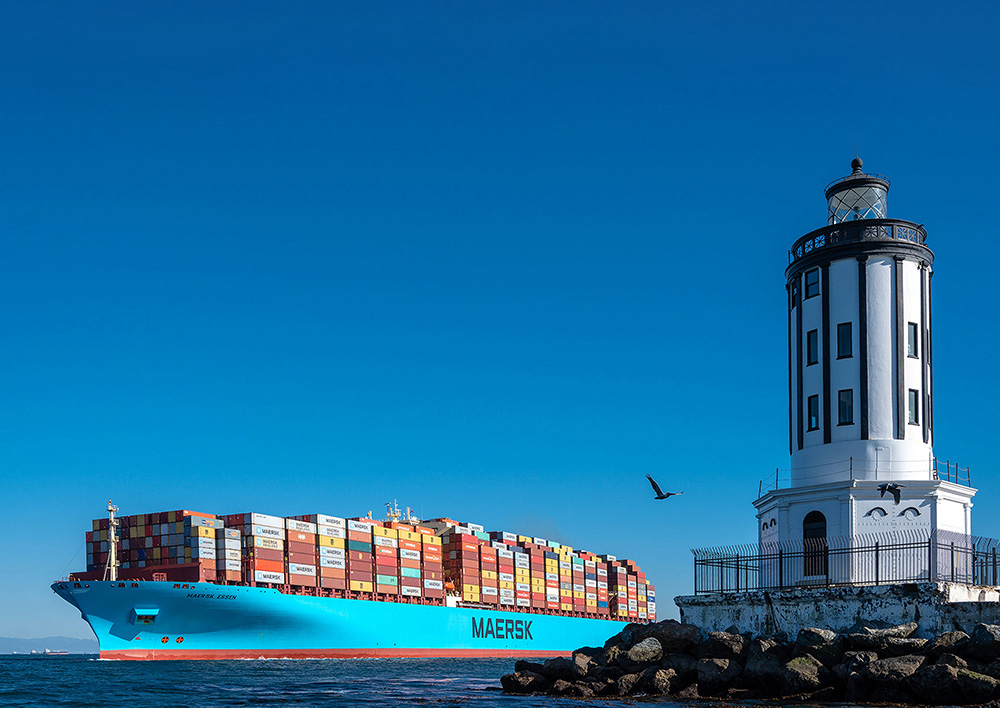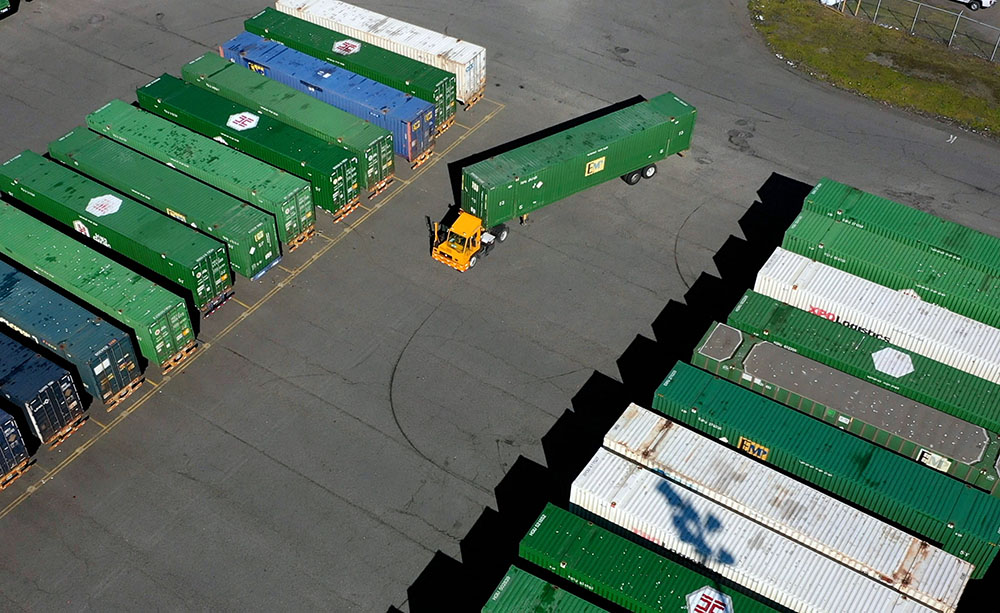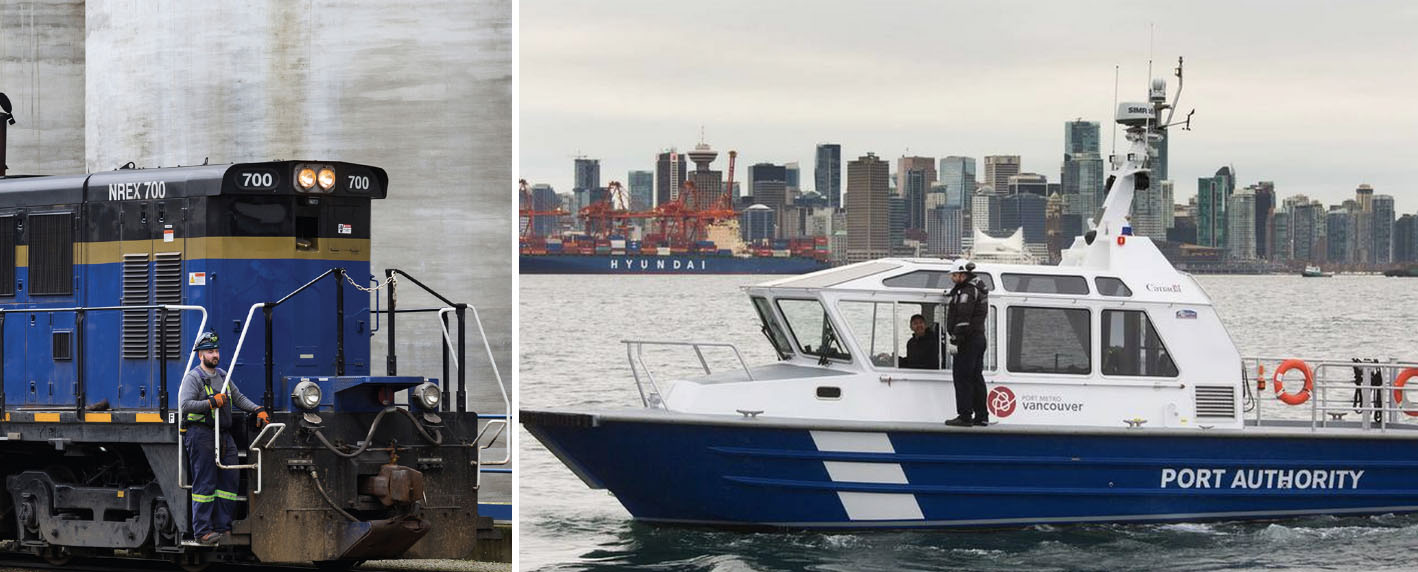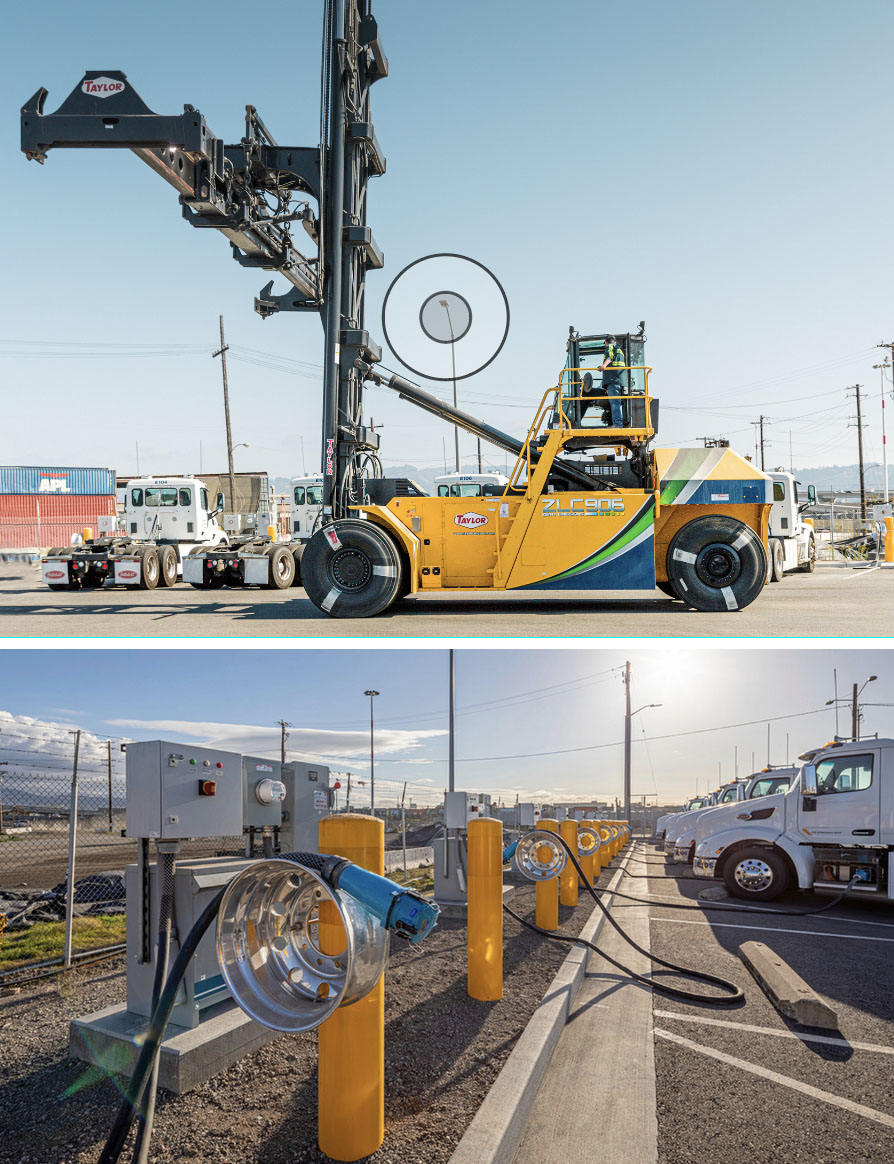
For a number of terminals on the Pacific coast, going “green” with environmentally friendly operations is also helping improve efficiency, save money on long-term plans and enhance health and safety for the port and neighboring communities.
Many major seaports have goals to reduce carbon emissions and are investing in cleaner technology, electrifying fleets and upgrading terminal equipment, both shoreside and on the water.
Pacific Maritime magazine reached out to a number of West Coast ports and marine terminal service providers to find out about the latest efforts and projects.
San Pedro Bay Ports
The Los Angeles and Long Beach ports have been working on “greening” both terminals for nearly 20 years, placing them ahead of the industry curve.
In 2006, they adopted the Clean Air Action Plan (CAAP), a first-of-its-kind program aimed at identifying and reducing emissions from port-related sources—ships, trucks, trains, terminal and cargo-handling equipment and harbor craft—through specific and ambitious, but achievable, goals, Port of Los Angeles Chief Sustainability Officer Chris Cannon explained.
Regarding terminal equipment, over the years they’ve encouraged early replacement of older equipment to zero-emissions equipment.
“We set a goal for ourselves for 2030 to have zero-emissions terminal equipment,” Cannon said.
The target is being taken very seriously, he noted.
“They’re testing right now. I think every single terminal is undergoing testing of different types of zero emissions equipment because they’re trying to make decisions now about infrastructure that they have to deploy over the next few years and then they start buying equipment,” he said. “It’s a very, very exciting time right now.”
Many of the terminals at the port are testing either battery electric or hydrogen fuel cell equipment, like top handlers or yard tractors, and wireless inductive charging systems.
The latest component of the port’s Clean Truck Program, implemented in early 2022, is a $10 per 20-foot equivalent unit fee charged on containers hauled by trucks, with exemptions for zero-emission trucks.
“The goal is to incentivize the harbor owners to start contracting with trucking companies that use zero-emission trucks,” Cannon said.
The collected funds will be used for vouchers, grants and other types of investments in clean trucks and clean truck infrastructure, he explained. There are 93 zero-emission trucks operating at the ports now and it is believed that members will be in the hundreds over the next two to three years, Cannon said. The goal is to have all the drayage trucks operating at the port be zero emissions by 2035.
They’ve also recently started work on establishing a “green shipping corridor,” which is essentially an extension of what they’re already doing with the CAAP, Cannon said. While the Cleaner Air Action plan concentrates on emission sources at the port, the corridor looks at the voyage.
“The green shipping corridor focuses on the journey, which is not just emissions and activity at the port, but emissions and activity all the way across the ocean,” he said.
The aim is to work with the various partners in the goods movement industry, the shipping line, other ports and cargo owners, he explained, to optimize the journey through improvements like digitization, clean-ship technologies and low-carbon (and ultimately zero-carbon) fuels.
“(Through corridor partnerships, they will) develop best management practices that allow the ship’s journey between Asia and the port here to be the most efficient and to have the least carbon index, or carbon emissions, that they can have,” Cannon said. “We like to think that if we can reduce the carbon intensity of the activities associated with goods movement and then that’s a good thing for the world.”
The corridor starts at the entry gate of the terminal, Cannon explained. The aim is to decarbonize all the activity at the terminal: The work associated with loading the cargo onto a ship, moving the ship out of the harbor (using tugs or the ship operation itself), and the actual journey out in the open ocean. To do this, they need to work collaboratively with the owners and operators of the ships, tugs, terminals and fuel providers.
“All of these are different players and we’ve gotten together with each of them and asked them to work with us to decarbonize goods movement and maritime goods movement,” he said. “They’re all partners in this corridor effort.”
The Port of L.A. started the effort with a memorandum of understanding with the Port of Shanghai in early 2022.
Most recently, officials are finishing work on an implementation plan for the corridor which, at the time of publication, will be released within a few weeks. The plan will detail the goals and targets both ports want to meet and how.
The West Coast port also signed an MOU with Singapore in April to start working on a green shipping corridor, while working with ports in Tokyo, Yokohama and Gothenburg on similar agreements.
In L.A., they already have their eye on an impressive target.
“We’d like to have (at least one) zero-lifecycle carbon ship operating between LA/Long Beach and Shanghai by 2030,” Cannon said.
Reaching zero-lifecycle carbon is a challenge, he said. Not only do the emissions coming out of the “tailpipe” have to be reduced, but the emissions on the production side as well.
“No net increase in emissions at all, from the operation of the ship, as well as the creation, and refining and delivery of the fuel,” he said.
By 2025, they hope to see ships capable of running on reduced carbon fuels, like methanol, begin to be deployed in the corridor.

Northwest Seaport Alliance
The Northwest Seaport Alliance gateway has made major strides in environmental programs in recent years.
The NWSA entered into a voluntary commitment alongside the Port of Seattle, Port of Tacoma and Vancouver-Fraser Port Authority to reduce maritime emissions to zero by 2050, Director of Communications Melanie Stambaugh said in a email.
Through the Northwest Ports Clean Air Strategy (NWPCAS), they work closely with customers, marine terminal operators, trucking companies, rail lines and others to reduce air pollution (especially diesel exhaust) and climate pollution (greenhouse gas emissions) from seaport activities such as container ships, cargo-handling equipment and drayage trucks.
“The Northwest Ports Clean Air Strategy outlines the broad vision as well as five-year implementation periods to ensure we achieve our zero-emissions goal,” Stambaugh said.
Key components of the work include adding shore power infrastructure to marine terminals, zero-emission cargo handling equipment at their facilities and working with the drayage truck community to move to zero-emission trucking fleets.
The NWSA recently completed a project that aligned with those goals with the installation of shore power infrastructure at Terminal 5 in Seattle. On April 10, MSC Brunella was the first vessel to plug-in and utilize the city of Seattle’s clean electricity grid instead of idling at berth.
“The Northwest Seaport Alliance is committed to reducing maritime emissions in our harbors and the launch of shore power utilization at Terminal 5 is an important milestone for our gateway,” NWSA Co-Chair Sam Cho said in a statement.
They are also in the process of design and construction of shore power at Terminal 18 and Husky Terminal in the gateway, Stambaugh added.
A second key component of the NWPCAS is to implement a Clean Truck Program. This exchanges older, more polluting vehicles with newer, cleaner trucks by offering rebates for the purchase of the new truck, while scrapping the older vehicle, Stambaugh explained.
Since 2005, the NWSA gateway has reduced diesel particulate matter emissions by more than 90%.
“All our international marine terminals require a truck to be model year 2007 or newer. Additionally, we’re working together with local, state and regional partners to facilitate a zero-emission truck collaborative to bring zero-emission drayage trucks into our gateway,” she said.
Through a key partnership in March 2022, the NWSA purchased six ell-electric, zero-emission cargo-handling yard trucks.
“These are operating in our South Harbor and have been a great experiment in showing the efficacy of zero-emission cargo handling equipment, which requires less maintenance over time,” Stambaugh said.
Tideworks Technology
Another way to improve efficiency is through smarter software. In recent years, terminals have moved toward utilizing smart technology with the goal of greener operations overall and a modernized operating system can make a notable difference.
The team at Tideworks Technology has seen this shift taking place across terminals worldwide, Mark Bromley, vice president of client management, explained.
The move to smart tech is partly with the goal of greener operations, he explained, but it also has an impact as terminal operators navigate ongoing fluctuations in container volumes, equipment access and space.
“Terminal operating system (TOS) solutions can be the foundation and starting point for many terminals’ modernization strategies,” Bromley said.
They are seeing more and more terminal operators have “smart” or “green” initiatives, and the company partners with them to understand their objectives and identify opportunities for productivity improvements and where automation might be effective.
“Modernized TOS is critical in providing terminal operators with the visibility to know what is happening in their terminal at any given time and then the ability to share that real-time information with their customers,” he said. “That visibility also goes hand in hand with accuracy and improving throughput.”
For example, with real-time data, operators can determine where to move containers, when to schedule pickups and when to utilize equipment to reduce emissions from idle times. Informed decision making across these elements leads to increased productivity and efficiency, which promotes sustainable practices.
In order for technology to be truly effective and “smart” for terminals, it must inject real-time visibility and predictability into operations, Bromley explained.
“Without meeting these criteria, sustainability efforts may not reach their full potential,” he said. “TOS solutions serve as the foundation for utilizing automation in a way that maximizes environmental, operational and cost benefits.”
Tideworks recently completed and launched a new product that helps terminals reduce unnecessary equipment emissions during training. The product, called DriverSIM by Tideworks, is a supplemental training tool that allows terminals to transition part of their equipment training to a virtual environment.
“Using a virtual-reality environment improves training outcomes and reduces emissions by decreasing equipment and fuel use,” Bromley said.
Tideworks successfully deployed the new simulated training solution at Manzanillo International Terminal in May. The firm partnered with MIT to create and test DriverSIM by Tideworks, Bromley said, creating a customizable solution that reflected MIT’s yard layout and drivers’ needs.
DriverSIM by Tideworks also provides real-time metrics to review training progress, improving operational efficiency and accuracy by helping perfect training on high-incident yard scenarios.
“Repeatable training can be costly and timely and emit avoidable emissions. Our tool helps reduce those costs to improve the safety of individuals operating the equipment and on the terminal,” Bromley said. “Innovations such as DriverSIM will continue enhancing efficiency and productivity at ports while helping meet cost and sustainability goals. We’re excited the solution is now available for all clients.”

Port of Vancouver
Efforts are currently underway to transition towards cleaner fuels and equipment at the Port of Vancouver.
To reach the Vancouver Fraser Port Authority’s goal of phasing out all port-related emissions by 2050, it’s critical that they support the adoption of new, low- and zero-emission fuels and technologies at the Port of Vancouver, said Ronan Chester, the agency’s director of Climate Action and Sustainability Leadership.
They partnered with the Province of British Columbia to jointly provide $3 million in funding toward the testing and demonstration of alternative fuels and technologies at the port through the Low-Emission Technology Initiative, he noted.
The effort to meet the 2050 goal also prompted a range of environmental programs and initiatives to reduce emissions from port activities, such as the EcoAction program, the Non-Road Diesel Emissions program and shore power technology.
To date, through the low-emission initiative, the port authority and the Province of B.C. have helped facilitate the testing and adoption of a range of alternative fuels and technologies in partnership with industry, Chester said.
In 2021, they partnered with Seaspan Ferries to test the use of 100% biodiesel on one of its commercial ferries, which transports containers of goods between Vancouver Island and the Lower Mainland. Following the success of that pilot project, Seaspan Ferries began running all six of its commercial ferries on 100% biodiesel. In addition to the testing of biodiesel, VFPA also helped Seaspan Ferries procure two battery-electric powered terminal tractors, which are currently in use at Seaspan’s Tilbury Marine Terminal on the Fraser River.
“This work with Seaspan Ferries is a great example of how pilot projects can be a catalyst for large-scale adoption of low-emission fuels and technologies,” Chester said.
In 2022, the Port Authority partnered with Shell Canada to test the use of 100% renewable diesel on one of the terminal locomotives operated by Viterra and on one of the port authority’s patrol boats. The change made VFPA the first such authority in Canada to run a vessel on 100% renewable diesel.
“Renewable diesel is a non-fossil fuel energy source derived from a range of organic sources such as vegetable oils, animal fats and food waste, and can result in up to 80% less net greenhouse gas emissions than regular diesel on a life-cycle basis,” Chester explained.

Port of Oakland
The Port of Oakland has significantly reduced emissions from seaport operations in recent years and their green efforts continue to grow with several recent actions.
According to the port’s 2020 and Beyond Plan, their vision is zero-emissions Seaport operations through changes in equipment, operations, fuels and infrastructure.
“Our commitment to zero emissions at the Port of Oakland will improve air quality, benefit our community’s health and create jobs,” Port of Oakland Executive Director Danny Wan said of the document outlining the plan. “This work will also help the state’s efforts to achieve air quality and climate targets.”
A number of recent decisions and efforts back that goal up.
The Oakland Board of Port Commissioners on March 9 approved an environmental ordinance that includes requiring tenants that operate cargo-handling equipment to create a plan for converting the equipment to zero-emissions.
Port tenants have until Dec. 31 to create a cargo-handling equipment conversion plan. The ordinance will allow the port to work collaboratively with its business partners to support an efficient and timely transition to zero emissions.
“We recognize there are technical and financial challenges to make major changes in operations,” said Port of Oakland Maritime Director Bryan Brandes. “We will continue to partner with our maritime tenants to help them achieve success on getting to zero emissions.”
In December, the port debuted two all-electric, zero-emissions top picks. Only a handful of these innovative pieces of equipment exist around the world, port officials noted in a Dec. 23 announcement. In Oakland, they are part of a demonstration project to create a zero-emissions seaport.
This project is part of the Zero- and Near-Zero-Emission Freight Facilities (ZANZEFF) program, which is funded by the California Climate Investments program. The Port of Oakland invested $2 million as a match to build the electrical substation powering the top pick chargers. Shippers Transport Express, a Port of Oakland tenant, installed the charging stations.
“Every step we take to use zero-emissions equipment is important,” the port’s Director of Environmental Programs and Planning Richard Sinkoff said in a statement. “What we learn from this demonstration project will help inform on-going and future Port of Oakland emissions reduction programs and equipment deployment.”
In January, port officials announced that utility serving customers at the seaport and airport fulfilled 66.9% of their power needs from carbon-free energy sources, nearly double the state average. The port owns and operates its own utility, which then sells electricity to tenants.
According to the 2021 Port Utility Green Power Portfolio, submitted to the California Energy Commission annually, the port utility supplied 49.9% of its power from eligible renewable resources.
“It’s rewarding to be able to harness the sustainable power of the sun, water, wind, waste products and geothermal sources to supply the port’s power needs,” said the port’s Manager of Utilities Administration Jared Carpenter.
About 30% of the port’s power comes from solar.
The Port of Oakland’s stake in a newly expanded solar array at Antelope Valley Solar Ranch came online and started delivering renewable energy to the port on Jan. 27.
“This is a project that has been six years in the making,” Wan said in a statement. “Using renewable power sources to meet our energy needs is another important step towards zero-emissions and a greener port.”
In March 2017, the port approved an $8.9 million deal to buy power from the Lancaster, Calif., based solar farm. The port agreed to purchase approximately 11,000-megawatt hours of electricity annually. The commitment is equivalent to using about 50 acres of the 1,300-acre solar array.
Sara Hall has 15 years of experience at several regional and national magazines, online news outlets, and daily and weekly newspapers, where coverage has included reporting on local harbor activities, marine-based news, and regional and state coastal agencies. Her work has included photography, writing, design and layout.
